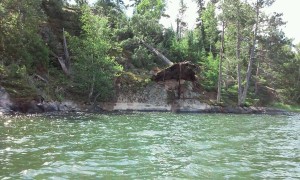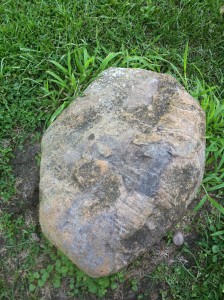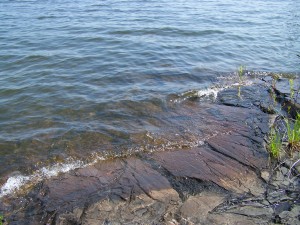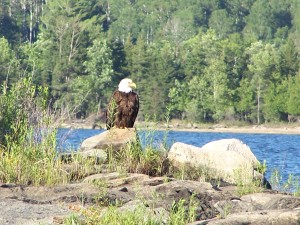My Pet Rock
About ten years ago, I was operating the chisel plow on our farm in Western Illinois when the whole machine suddenly lurched and there was a loud bang from somewhere behind the tractor. I stopped and raised the implement out of the ground to see if there was any damage. What I discovered was a broken, but replaceable, shear bolt and partly buried in the newly worked soil, a big rock. The rock was unremarkable. It was grey, as many rocks seem to be, and round mostly, and scratched up, at least partly from being hit by a chisel plow. Its most remarkable feature was its size. We don’t see many this big around here. I made a half-hearted effort to kick it loose from the soil but discovered that gravity had a determined hold on it. It was not going to be kicked out of the way. I went on about my plowing and forgot about the rock.
Our farm is not a “rocky” farm like you sometimes see in Minnesota. It has pretty good soil and is fairly productive by modern corn and soybean yield standards. This rock definitely didn’t belong. It was an alien. In the Fall, my daughter and I took a shovel and our little wagon and dug the rock out of the hillside. I could not lift it but, using the tilt mechanism, was able to roll it into the wagon’s bed and rotate it up into place. We hauled the rock up to our house yard and dumped it near our campfire ring as a place for kids to sit while roasting marshmallows. I didn’t think too much about the rock after that except that I did a little investigation to eliminate the enticing possibility that it was a meteorite. No such luck. A meteorite that big would be extremely interesting not to mention extremely valuable. But, despite being terrestrial, my “pet” rock, it turns out, has a name, and a story as interesting as any space rock. It is called a “Glacial Erratic” and it’s story is about geology and history and travel.
When I say Rock, I Mean Rock
For many years my family has taken an annual fishing trip to Lake of the Woods in Ontario, Canada. I love nearly everything about Lake of the Woods. The fishing is great, the people are friendly, the weather is generally cool and dry when ours is hot and humid. But the thing I really like about Lake of the Woods is the austere, almost harsh beauty of the place. It is a tough environment for both plants and animals. The winters are brutal and the insects can be fierce. But what makes Lake of the Woods a truly harsh place for life boils down to one thing, soil, or rather, the lack of soil. Plants don’t grow well without soil and animals do not live very well without plants.
Lake of the Woods is famous for rocks. The incautious boater can be skimming across Whitefish bay over 180 feet of water and a few seconds later can be surprised by the silence of his now absent outboard motor which has been sheared cleanly off the back of his boat by a boulder. The islands here are rock, the shorelines here are lined with rock, the houses here are built on top of rock. There are no wells. Septic tanks and drain fields simply don’t exist. Bedrock defines this place because that is what you can see.
When you spend a bit of time on Lake of the Woods you begin to notice interesting things about the terrain. One thing you notice, right off the bat, is that there is no dirt, or almost none. The reason you can see the bedrock, and hit it with your propeller for that matter, is that there is no dirt to cover it. When you pull up on an island to have a shore lunch you unload your snacks and cooler and so forth and you sit down on a rock to contemplate the beauty. What you notice, often, is that the rock you are resting on is itself resting on an enormous dome of granite sticking out of the lake. This rocky island frequently seems to be one big rock polished almost smooth across its surface but frequently bearing deep scratches, mostly parallel, and mostly aligned in a southwestward direction. This observation can be repeated all over northern Lake of the Woods and it gets a thoughtful person to thinking. As you ponder the scratches, and possibly scratch your own head, you might begin to contemplate the big round rock you are sitting on. It doesn’t seem to belong in this spot any more than a big, roundish, grey rock belongs in an Illinois cornfield. It is rock, of course, much like the island it sits on. But it is different in color and texture and appearance from the rock of the island. And it sits so oddly upon this smooth dome of rock that it appears to have been dropped here by some larger power as a sort of practical joke. The out of place rocks here and in Illinois were indeed placed by a larger power, larger than us, anyway. They are, quite literally, out of place. And they both share that same unusual name, “Glacial Erratic.”
As we sit upon this glacial erratic and nibble a piece of cold walleye, our thoughts turn back to the mystery of the missing soil. We ask ourselves questions. Where is the soil? Was it ever here? What could possibly move so much soil and scour the rocks so clean? The answers are quite interesting. The soil that is not here on the Canadian shield did not disappear, it was hauled away and with it many, many little grey rocks. The soil, and the gravel, and the rocks were moved, as it turns out, to Illinois. The fertility which we do not find in northwestern Ontario is now producing 200 bushel/acre corn near Rockford. Left behind are rocky islands covered with scratch marks and an occasional giant boulder sitting incongruously atop a flat bedrock shelf. The trees which make up the “woods” of Lake of the Woods must make do with wind-borne accumulations of dirt which have collected in cracks in the rock. Limited in nutrients and susceptible to erosion these little “planters” make poor growing places but, as I noted in my essay The Sycamore, nature makes use of whatever is available to it. The trees here do grow tall, but they do it very slowly. Often there is not enough soil on a barren rock to hold up a sixty foot pine in a wind storm. You can see examples all over the lake of horizontal trees with their entire root ball and attached soil thrust up into the air.

An Excellent Photo by my Aunt, Judi Roberts, shows exactly what I’m describing here. Notice how this 50 foot pine grew from just a few inches of soil. Unfortunately it wasn’t enough.
A Larger Power
If you can picture in your minds-eye a mountain of ice nearly a mile thick where Chicago sits today, you have a better imagination than me. And yet, during the Illinois Glacial Episode (About 125,000 – 300,000 years ago) and the Wisconsin Glacial Episode (About 10,000 – 25,000 years ago) such was the state of affairs in our neck of the woods. During the height of the Illinois glaciation ice sheets hundreds of feet thick extended all the way to Carbondale. This was the farthest south glaciers ever penetrated in North America. The ice covered nearly 90% of what is now the Prairie State sparing only extreme southern Illinois and some high elevation areas near Galena. Up in Canada these ice sheets grew thicker yet, up to 8,000 feet deep in places. (Think of 125,000 years of snow falling but never melting). This dome of ice thickened and as it thickened the weight of the ice and snow compressed the earth beneath it and caused it’s lower margins to be pushed outward and begin to “slide.” This movement ultimately became a glacial front pushing relentlessly southward, sometimes at a third of a mile per year, like an unbelievable bulldozer. These lobes of ice representing billions of tons of pressure scoured the surface of the land in what is now the Canadian Shield (places like Lake of the Woods). The expanding glacier carried away the soil and through a process called “plucking” quarried out and picked up great rocks and boulders and ground them along the bedrock, rounding and polishing them and leaving parallel scratches on the rocky islands of Lake of the Woods. Smaller stones were ground into pebbles, pebbles were ground into sand and sand was ground into fine particles of clay. Moving southward over Canada and Minnesota and Wisconsin and the basin of Lake Michigan these glaciers accumulated great “loads” of soil and rock. This load of material and debris is called “drift.”
The bulldozer/glacier analogy is imperfect. Although glacial fronts did “plow” rock and soil ahead of them much like a bulldozer a great deal of the drift was ultimately carried inside the glacier. Glaciers are ice, after all, and subject to freezing and thawing cycles. Most boulder “plucking,” for example was caused by melt water beneath the glacier freezing in cracks in the bedrock below and splitting off pieces which became imbedded in the overrunning ice. Sometimes landslides from nearby higher elevations fell onto the top of a glacier and were carried along, not in front of the dozer, but far back along the glacier’s side.
And there was not one massive dozer of a glacier which pushed down to Carbondale, Illinois and then disappeared. At least four, and possibly eight, times Illinois was partly or mostly covered with ice. Even these measurable events did not represent single glacial fronts, but many lobes advancing and retreating, advancing and retreating. When the temperature fell over a long period the ice would advance and the bulldozer effect would be an apt description. When temperatures rose, the ice would melt back leaving a ridge of soil and debris called a moraine. Though you may never have noticed them, Illinois is covered by moraines. The moraines southwest of Chicago left behind by the last Wisconsin glaciation event are the most prominent in the state. And glaciers don’t just melt on the southern leading edge; they melt on top, also. At times great rivers of melt-water flowed on and over the glacier itself, carrying their own loads of soil and flowing down into crevasses in the ice to emerge from under the glacier. In some places, the gravel and sand carried across and through the ice by these melt-water streams ultimately settled to earth to form gravelly ridges called eskers.
Making Topsoil
Ultimately the glaciers did retreat. They melted and the drift they carried was dropped on the sandstone and shale underlying Illinois. This “dropped drift” is called “till” and it is estimated that this till layer made up of soil, gravel, clay, pebbles and rocks, covers nearly 90% of the state and averages 100 feet deep. It can, in places reach 500 feet. When we drilled a water well at our house some years ago, the driller went down 485 feet to find the purest drinking water. It is this layer of drift which filters our water.
Glaciers did not merely drop their load. The enormous volume of water generated by melting hundreds or thousands of feet of ice moved soil, too. As water flowed out from the glacier, it carved great valleys and small stream beds. The present course of the Mississippi, Illinois, and Ohio rivers were determined by glacier outwash. As the melt-water ebbed, and the sediment left in the smaller stream beds and larger valleys dried out, the wind tended to pick up the smaller, lighter particles and scatter them across the thick layer of drift. This fine soil is called loess and it covers much of Illinois, often to a depth of 20 feet.
Farmers today often think of themselves as stewards of the soil. This is, indeed a noble idea. But the amazing fertility which makes Illinois a “rich” state is only marginally related to agricultural practices. Illinois’ amazing crop yields and subsequent wealth (The average price for an acre of farmland in Illinois in 2014 was $7,700) are a direct result of this glacial windfall (loess being literally a windfall). Rich till and loess hundreds of feet deep were the perfect substrate for the forbs and grasses which ultimately covered Illinois and made it The Prairie State. Thousands of years worth of living and dying prairie plants generated thousands of years worth of organic matter which was stored up in the form of rich, black topsoil which now grows 200 bushels of corn per acre.
And what of Canada? Our gain, crop-wise, was their loss. You cannot grow corn, or much of anything, on a rock. But while row upon row of golden cornstalks reaching to the horizon do have a certain esthetic beauty, a bald eagle, perched on a pine tree does, too. If the Canadian Shield had kept its soil the austere beauty of Lake of the Woods that I appreciate now might have been simply a continuation of the vast wheat fields of Saskatchewan further west. I guess I like the way things turned out.
The Wanderer
A glacial erratic is a rock that differs from the size or type native to the area in which it is found. It can be as small as a pebble or as large as a house. The name erratic comes from the latin term errare which means to wander or go astray. I like that. I like to think of my little glacial erratic as I sit by the campfire. I like to imagine my pet rock being liberated from some shelf along the shores of Lake of the Woods and rolled and rounded in the belly of a mighty glacier for hundreds of miles across Minnesota and Wisconsin. And I like to imagine standing on the terminal moraine of this glacier as it slowly melts and recedes, leaving a hill which today comprises our cornfield. On the crest of the moraine sits a little rock left behind by the ice. It is covered, over time, with windblown loess from the nearby “new” Mississippi River. Generations of men plow this soil and plant corn and pick corn and plant again until one day a young man on a John Deere tractor plows deep enough to bring the little rock to the surface again.
The Philosophy Bit
My Mom and I sometimes like to look up into the night sky and watch for meteors. There is something about witnessing these little wanderers that makes one feel simultaneously very small, but also very lucky. We feel small because compared to the scale of the galaxy our little soap opera represents nothing. We are a blip in both time and space and the things that we worry so much about mean nothing to the universe. But we are lucky, too. And we are special, in a way. When my Mom and I sit outside at midnight watching for a falling star we are witnesses to nature’s power. We, unlike any other creature or thing, have the unique ability to see, understand, and assimilate these wonderful forces that swirl all around us. In his poem The Star Splitter Robert Frost says “The best thing that we’re put here for’s to see.” I think there is something in that. Whether it be a falling star or a rock carried by a glacier the world, and indeed the universe, is filled with things worth seeing and worth trying to understand. Until I learned a bit about glacial erratics I knew next to nothing about this farm we live on and why it is so good. I did not know why the Lake of the Woods was so beautiful.
Does it benefit our appreciation to also understand? I think it does. I think I appreciate things more when I can comprehend also the amazing power and endurance and scale of this incredible world. It is a cool place and it is worth knowing. Sometimes that starts with a little grey rock.
Text by: Dustin Joy
Photos by: Judi Roberts and Dustin Joy


